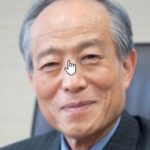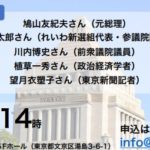The Keynote Speech at the International Day of Peace at Yinchuan, China,
September 16th, 2016The Road to Sustainable Peace and Security in Asia for East Asian Community
Eiichi Shindo, Professor Emeritus, Tsukuba National University
President, Global Asia Institute if Research Alliance (GAIA) Foundation
Professor Emeritus, Tukuba National University
Ⅰ
It is honor of me to make a speech about sustainable peace and security in the twenty-first century. We have realized the fact that the military and state centric paradigm could not work anymore in the twenty-first century..
We should precede the road neither to military-oriented peace nor state-first security. They could not sustainable. The sustainable peace could be only possible by strengthening civic capacities rather than by military capabilities. The sustainable security could only be possible by ensuring the minimum living standards of the ordinary people rather than by the maximum military standards of the nation. Societal security rather than national security must be put first.
We must seek peaceful co-habitance with our neighbors.
We should promote economic-societal cooperation system rather than military alliance system. The road to sustainable peace and security in the twenty-first century could be delineated by the following three ways.
Ⅱ
First, we have to spend more money and resources on non-traditional security areas such as poverty, famine, endemic diseases. Human security must got priority. It is because war and conflict in the twenty first century originate in poverty and famine.
Hence, we have to promote the cooperative activities to reduce poverty and environmental degradation through developmental aids and active cooperation of the advanced countries.
The military sanction against the so-called “rogue states “ or the states with bad behaviors such as Iran, Cube and North Korea dictated by the US have turned out to be dysfunctional. It has had only worked to increase counter aggressive, sometimes risky, reactions on the side of the sanctioned nations to sustain their own national security.
Ⅲ
Second, we should open up the way towards disarmaments among nations. We should also develop the regional scheme of crisis management to prevent unexpected incidents. What we have to realize is disarmament agreements rather than arms control based on the status quo of weapons of the nations concerned. What we should step forward is mutual reduction of lethal weapons, either nuclear or non-nuclear.
We assumed that after the end of the cold war we would have a new era of eternal peace. We, however, have had a series of wars and conflicts in the Balkan and Middle East, after the trapped Iraq war of 1991 and its aftermath. The aftermath has been succeeded by the wars of terror as well as the wars of anti-terror after 9.11.
We have begun a new century od new war-games. Their new leading actors have been the new kind of military industrial complexes led by the Civil Military Enterprises with the arms industries and the Pentagon. Undoubtedly they have had produced the crises in the conflict-lidden areas from the Middle East through the Korean Peninsula.
The bombers of drone as well as Osplay and THAAD, the new products of the Revolution of Military Affairs have continued to lead the counter-armament on the side of the potential enemies such as North Korea and Islamic states.
We should instead start up for the mutual confidence building measures and the GRIT (Gradual Reciprocation of Initiatives for Tension reduction) processes. The diplomatic talks among nations concerned are desperately needed to reduce tension to get sustainable peace in the region.
Ⅳ
Third, we should promote the East Asian community building processes. We should learn the lesson of history of Europe. Europe initiated by the cooperative production scheme of coal and steel in Rule region to create the non-war community
As in Western Europe, we, Asian peoples, should follow their scheme to shelve the contested territorial problems . We should design or redesign the win-win cooperative security scheme for joint production of natural gas in the Sea of East China as well as in the Sea of South China. Then we could step up towards the cooperative processes to promote the de-fact rather than de-jure regional integration in East Asia.
For these purposes, we will have to make means that we should make incessant efforts to solve the history problems and to make our faithful apologies to our neighboring nations and peoples. We, the members of Association to Succeed the Statements of the Premier Murayama, have focused our daily activities on this thorny unsolved problem. And I myself has had played the pivotal roles of architect of East Asian community building as the vice chairman of the Council of East Asian Community, the track two diplomatic state organization, as well as the President of International Academic Society for Asian Community.
Through my involvement in the regional policy making in the East Asian community building, I could summarize the current policy agenda as follows, particularly after the establishment of ASEAN Economic Community last year.
As you know, TPP, the pan-pacific free trade agreement led by the United States and Japan has turned out to be almost failed. Instead of TPP, RCEP as another regional agreement has regained reality as the one of comprehensive economic partnership led by ASEAN +3 (China, Japan and Korea) and +3 (India, Australia, and New Zealand). It has been in the finalizing processes of de-fact rather than de-jure community building processes.
The basic scheme comprises the three pillars.
The first pillar is trade and production cooperative scheme based on the so-called values-chain networks a la module productions in the region. The second pillar is the development and construction cooperative scheme to improve poor infrastructure and connectivity in the region. The AIIB, the Asian Infrastructure Investment Bank, would work well for this second pillar of community building.
The third pillar is financial and socio-cultural cooperative scheme to sustain the political regional integration processes.
These three pillars of East Asian community building scheme could certainly be the last crux of sustenable peace and development the twenty- first century Asia and world.
コメント
この記事へのトラックバックはありません。






この記事へのコメントはありません。